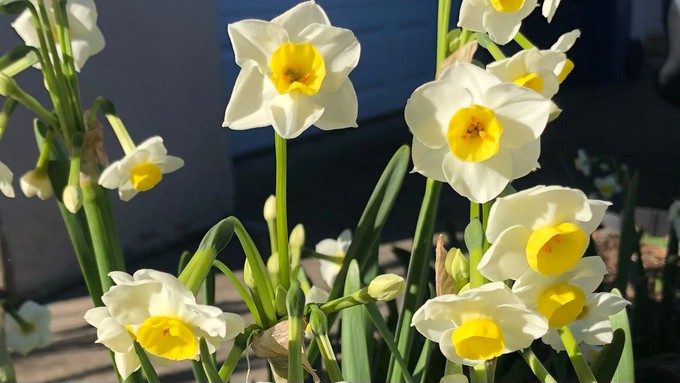
Sacramento's February weather outlook looks good for gardening

Thin winter sunshine highlights narcissus in bloom. We could have more dry days than wet this month. Kathy Morrison
After a very wet January, what can we expect in February?
Will our local groundhogs (OK, they’re ground squirrels) see their shadows on Thursday’s Groundhog Day? More important: After three years of drought, can we expect more rain?
Accuweather predicts a few other stormy days this month with the longest stretch of wet weather likely to be Feb. 20-23. Even then, rainfall totals are expected to be low.
That is unlikely to fulfill February’s average rainfall total. This month’s rainfall in non-drought years averages 3.63 inches – a major chunk of our annual total.
Our February days will be mild, predict the weather experts. Most of this month will be right around average – highs of 60 and lows of 42 – before warming into the high 60 by month’s end. But record temperatures (high of 76 degrees and low of 23) on either end of the scale are unlikely.
December and January storms have put plenty of moisture into our water bank. Downtown Sacramento totaled 9.52 inches in December and 7.54 in January; those two months almost surpassed our annual average of 17.6 inches.
Heavy Sierra snowpack looks like it will assure relatively good snow melt – and fuller reservoirs. Our drought isn’t over – yet – but we at least have a more positive water outlook for the hotter months to come.
Before turning on the sprinklers or irrigation system, check soil moisture; your landscape may not need watering. With these cooler temperatures, soil is slow to dry out, and plants may get too much water. Be on the lookout for crown rot.
Expect to see rapid growth sooner than later this month. Prompted by rain on the warmer side, daffodils and other bulbs have been quick into bloom. Newly pruned roses are sprouting shoots. Buds are already swelling on fruit trees.
This could be a good month to plant bare-root trees and shrubs, too. The same goes for perennials. They’ll put down roots quickly in that moist soil.
Afternoons in the high 60s are forecast for the last week of February, ending winter on a warm note. Maybe we’ll be in for an early spring, no matter what the groundhog’s shadow predicts.
Comments
0 comments have been posted.Sacramento Digs Gardening to your inbox.
Sites We Like
Garden Checklist for week of July 21
Your garden needs you!
* Keep your vegetable garden watered, mulched and weeded. Water before 8 a.m. to reduce the chance of fungal infection and to conserve moisture.
* Feed vegetable plants bone meal, rock phosphate or other fertilizers high in phosphate to stimulate more blooms and fruiting. (But wait until daily high temperatures drop out of the 100s.)
* Don’t let tomatoes wilt or dry out completely. Give tomatoes a deep watering two to three times a week.
* Harvest vegetables promptly to encourage plants to produce more. Squash especially tends to grow rapidly in hot weather. Keep an eye on zucchini.
* Pinch back chrysanthemums for bushy plants and more flowers in September.
* Remove spent flowers from roses, daylilies and other bloomers as they finish flowering.
* Pinch off blooms from basil so the plant will grow more leaves.
* Cut back lavender after flowering to promote a second bloom.
* It's not too late to add a splash of color. Plant petunias, snapdragons, zinnias and marigolds.
* From seed, plant corn, pumpkins, radishes, winter squash and sunflowers.